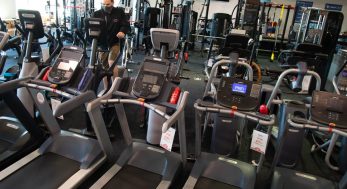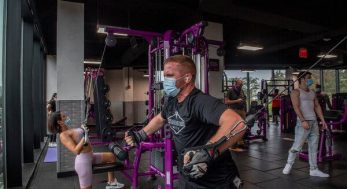Advertisement
Motivating clients to push themselves by shouting at high volume can compromise fitness instructors’ vocal health.

Coco Cohen is a triathlete. She has competed in Ironman competitions, has a black belt in karate and is a trained sword fighter.
But nothing could quite prepare her for the trials of shouting at top volume all day, several days a week, to her classes at Columbus Circle Equinox health club, where she is a manager and group fitness instructor. It turns out that shouting repeated encouragements during spin class — “Rise out of the saddle and push!” or “Trust yourself!” — is an occupational hazard.
“I sounded like Kathleen Turner on a downward spiral,” said Ms. Cohen, who, in a compounding irony, is also a trained professional singer. (She spent her 20s belting out standards by Pink, like “Glitter in the Air” and “Who Knew.”) As her voice grew huskier and the nodes on her vocal cords grew more callused, it took just one cough — the kind you make when water goes down the wrong pipe — for Ms. Cohen to get vocal paralysis. She could barely speak above a whisper, if at all, and had the same type of surgery that Julie Andrews had in 1997 after starring in “Victor/Victoria” on Broadway. (Ms. Andrews’s surgery was botched and left her unable to sing, but Ms. Cohen described hers as successful.)
Talk to surgeons and speech language pathologists, and you quickly learn that there’s a whole universe of professionals at risk for vocal damage whose job descriptions, technically, do not emphasize the use of their voices at all. Like teachers, for instance. Also lawyers. And a growing number of group fitness instructors like Ms. Cohen.

“This is a group that is so mindful of being healthy and taking care of their bodies, but their voices are really neglected,” said Leanne Goldberg, director of Grabscheid Voice and Swallowing Center at Mount Sinai Hospital in New York City.
Comprehensive data on this particular population is limited, but a small body of evidence suggests that fitness instructors are now among those at high risk. In 2016, Christine Estes, a speech language pathologist at the Weill Cornell Medicine Sean Parker Institute for the Voice, noticed that her patients featured a recurring cast of fitness instructors. She decided to conduct a study of them over a two-year period. What she discovered amazed her: They had polyps. They had nodules. They had hemorrhages. Real damage to the vocal cords that needed real treatment. All 24 were referred for behavioral treatment, and 10 opted to have surgery.
Instructors typically average around 15 classes per week, some starting as early as 5 a.m. Many lead several classes back-to-back, with almost no breaks in between. Throughout the day, they’re shouting directives — often while demonstrating the moves they’re describing — over loud, upbeat music and, in some cases, competing with the noise coming from treadmills, stationary bikes and clanging weights.
Most of all, they’re motivating their clients to push themselves, and that motivation generally takes the form of volume. And while most instructors do wear microphones, those devices may not help much if the studio has a low-quality sound system, or if the instructors don’t know how to use them to their vocal advantage. A result: Many instructors compromise their vocal health by giving what is a very taxing performance.
Complicating matters even further, the fitness industry has grown more competitive in recent years — in no small part because gym members can rate their instructors online, leaving reviews that someone was “inspiring.” As the industry becomes more exacting, so do instructors’ appetites to be the very best at their jobs. New instructors “are hungry,” Ms. Cohen said. “They’ll teach class after class, and I’ve started to warn them: Your voice will be gone.”
Patrick Frost, now a Nike Master trainer and the creator of Frostfit, started his fitness career nearly a decade ago at Barry’s Bootcamp, a full-body treadmill-and-weights workout studio with locations around the world. He quickly rose through the ranks and, by his account, was teaching close to 22 classes per week.
“Talk to any other instructor,” he says. “If you say you teach 22 Barry’s Bootcamp classes a week, they’ll tell you ‘that’s insane.’” Which is probably why, about two years into his job, Mr. Frost was frantically casting around for last-minute subs and calling in sick.
“Sometimes I’d wake up and not even know if I had a voice,” he said. He soon discovered he had major vocal cord polyps, with some hemorrhaging. To conserve his voice, Mr. Frost often found himself choosing between his career and his social life. He eventually had surgery in February 2015. As part of his recovery, Mr. Frost had to be diligent about his at-home exercises, warming up his voice by doing trills and repeating lines he’d say to his classes (“My name is Patrick Frost, Frost like the snowman”) at various volumes and pitches. “Mind you, I’m doing this in the shower, at 5 a.m., getting ready for work and dating somebody brand-new,” Mr. Frost said.
Stories like Mr. Frost’s are becoming more common as the industry expands. (According to the Bureau of Labor Statistics, employment for trainers is projected to grow 13 percent by 2028, faster than most occupations.) Take the case of Gerren Liles, for instance. He works not only for Equinox, but also for Mirror, a fitness start-up that streams fitness classes right into a person’s home (via a special wall-mounted mirror — hence the name). With that, Mr. Liles’s class load went from 14 per week to 25. Even before joining Mirror, he had vocal problems, and his expanded schedule only exacerbated them. Mr. Liles said that when it became “really, really painful,” he underwent surgery this past March, posting photos on Instagram.
“I needed to be able to present myself at my best,” Mr. Liles said, explaining his decision to have the operation. His career had reached a point where his future depended on the strength of his voice. It wasn’t just enough to look good; he had to sound good, too.
“These people are vocal athletes,” Ms. Goldberg said.
Many fitness instructors work freelance and may not have health insurance that covers treatment for vocal injuries. If they defer treatment, the damage can get worse. Instructors and experts alike say that education about vocal health should be required for new hires.
Some trainers are taking the initiative independently. At Equinox Columbus Circle, for example, Ms. Cohen said that she and a colleague organized a few sessions for other instructors focused on vocal health and made some information available to other instructors online.
Practicing good vocal hygiene includes staying hydrated; keeping studio music at lower levels; reducing unnecessary patter; and, when possible, leaving space between classes. Most important, though, it means instructors must develop the same vocal habits as professional singers. Namely, they need to warm up. A few minutes of humming, lip trills or resonance exercises can go a long way. And Ms. Estes recommends keeping most headset microphones two finger-widths from the corner of the mouth, but this can vary based on the amplification system.
“You think you don’t need something, like warming up your vocal cords or drinking that extra glass of water,” Ms. Cohen said. “But you do.”

